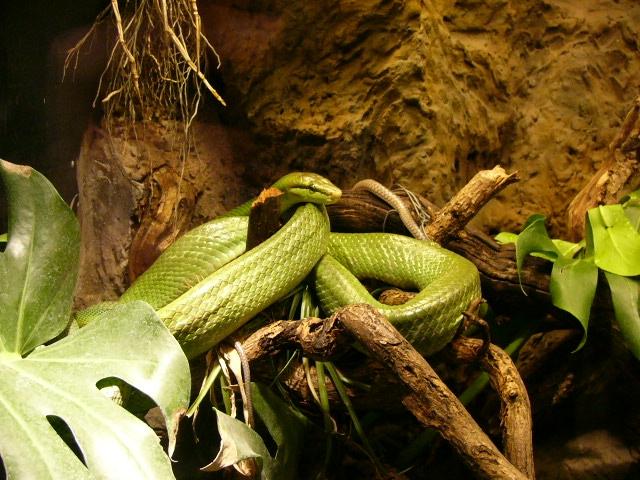Scientific classification:
Kingdom: Animalia
Phylum: Chordata
Subphylum: Vertebrata
Class: Reptilia
Order: Squamata
Suborder: Serpentes
Family: Colubridae
The Common Garter Snake (Thamnophis sirtalis) is a snake indigenous to North America. Most garter snakes have a pattern of yellow stripes on a brown or green background and their average length is about 50 cm (20 in), maximum about 125 cm.
Life history
The Common Garter Snake is a diurnal snake. In summer, it is most active in the morning and late afternoon; in cooler seasons or climates, it restricts its activity to the warm afternoons.
In warmer southern areas, the snake is active year-round; otherwise, it sleeps in common dens, sometimes in great numbers. On warm winter afternoons, some snakes have been observed emerging from their hibernacula to bask in the sun.
Toxicity
The saliva of a garter snake may be toxic to amphibians and other small animals. For humans, a bite is not dangerous, though it may cause slight itching, burning, and/or swelling. Most garter snakes also secrete a foul-smelling fluid from postanal glands when handled or harmed.
Reproduction
In the early part of spring, when snakes are coming out of hibernation the males generally emerge first to be ready when the females wake up. Some males will assume the role of a female and lead other males away from the burrow, luring them with a fake female pheromone. After such a male has led rivals away, he "turns" back into a male and races back to the den, just as the females emerge. He is then the first to mate with all the females he can catch. There are generally far more males than females and that is why, during mating season, they form "mating balls," where one or two females will be completely swamped by ten or more males. Sometimes a male snake will mate with a female before hibernation and the female will store the sperm internally until spring, when she will allow her eggs to be fertilized. If she mates again in the spring, the fall sperm will degenerate, and the spring sperm will fertilize her eggs. The females may give birth ovoviviparously to 12 to 40 young from July through October.
Habitat
The habitat of the garter snake ranges from forests, fields, and prairies to streams, wetlands, meadows, marshes, and ponds, and it is often found near water. It is a semi-aquatic animal like most snakes. It is found at altitudes from sea level to mountain locations. Their diet consists mainly of amphibians and earthworms, but also fish, small birds, toads, and rodents. Garter snakes are effective at catching fish and small to medium tadpoles. Animals that eat the Common Garter Snake include large fish(such as bass and catfish), bullfrogs, snapping turtles, milk snakes, hawks, skunks, foxes, and domestic cats.
Conservation
Water contamination, urban expansion, and residential and industrial development are all threats to the garter snake. The San Francisco Garter Snake (T. s. tetrataenia), which is extremely scarce and occurs only in the vicinity of ponds and reservoirs in San Mateo County, California, has been listed as an endangered species by the U.S. Fish and Wildlife Service since 1967.
Alfred Edmund Brehm: Az állatok világa - Légrády testvérek (1905)
http://hu.wikipedia.org/wiki/Sikl%C3%B3f%C3%A9l%C3%A9k
http://www.freeweb.hu/hobbiallat/cikkek/hullo60.htm
